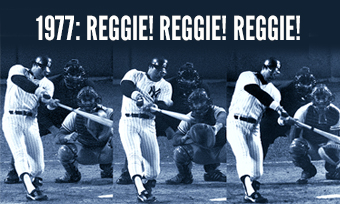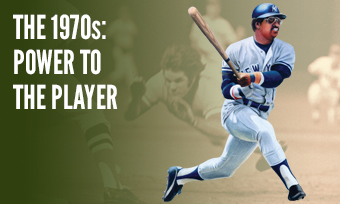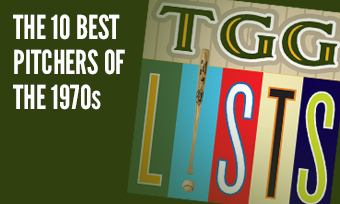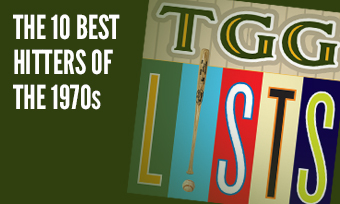The Yearly Reader
Leaders and Honors, 1977
Our list of baseball’s top 10 hitters and pitchers in both the American League and National League for the 1977 baseball season, as well as the awards and honors given to the game’s top achievers of the year.
The National League’s Top 10 Hitters, 1977
Bold type in brick red indicates league leader.
1. George Foster, Cincinnati
Key Numbers: .320 average, 124 runs, 197 hits, 31 doubles, 52 home runs, 149 RBIs, .631 slugging percentage.
Once a mere supporting cast member of Cincinnati’s Big Red Machine, Foster exploded into the role of the game’s top gun; he’d be the only major leaguer to crush 50 or more homers in a season between 1966-89.
2. Greg Luzinski, Philadelphia
Key Numbers: .309 average, 99 runs, 171 hits, 35 doubles, 39 home runs, 130 RBIs, 80 walks, 140 strikeouts.
Hitting .300 with power for the third straight year, Luzinski for now looked to have better odds of taking up future Hall-of-Fame space over Phillies teammate Mike Schmidt. He also managed to wrestle away nine first-place MVP votes from Foster and his juggernaut numbers—probably because the Phillies went to the postseason and the Reds didn’t.
3. Mike Schmidt, Philadelphia
Key Numbers: .274 average, 114 runs, 27 doubles, 11 triples, 38 home runs, 101 RBIs, 104 walks, 15 stolen bases.
Schmidt hit 13 of his home runs over just a 21-day stretch in June; overall, he hit 36 for the fourth straight year.
4. Reggie Smith, Los Angeles
Key Numbers: .307 average, 104 runs, 27 doubles, 32 home runs, 87 RBIs, 104 walks, .427 on-base percentage.
Tied for most home runs by those named Reggie in 1977: Reggie Jackson and Reggie Smith. The latter was one of four Dodgers to hit at least 30, a major league first; all four, including Smith, set career highs.
5. Joe Morgan, Cincinnati
Key Numbers: .288 average, 113 runs, 21 doubles, 6 triples, 22 home runs, 78 RBIs, 117 walks, 49 stolen bases.
A mild drop-off for the two-time defending NL MVP—hey, you can’t be Superman forever—but still very dangerous.
6. Dave Parker, Pittsburgh
Key Numbers: .338 average, 107 runs, 215 hits, 44 doubles, 8 triples, 21 home runs, 88 RBIs, 17 stolen bases, 19 caught stealing.
The Cobra won his first of back-to-back batting titles, edging out teammate Rennie Stennett by two points; twice he ran up hitting streaks to 22 games.
7. Johnny Bench, Cincinnati
Key Numbers: .275 average, 34 doubles, 31 home runs, 109 RBIs.
Like Joe Morgan above, Bench had his last statistically impressive year as age and general wear-and-tear began to take its toll.
8. Steve Garvey, Los Angeles
Key Numbers: 162 games, .297 average, 646 at-bats, 91 runs, 192 hits, 25 doubles, 33 home runs, 115 RBIs.
Despite accessing some of the best slugging numbers of his career, Steve Garvey failed to reach 200 hits for the only time between 1974-80.
9. Bill Robinson, Pittsburgh
Key Numbers: 137 games, .304 average, 32 doubles, 26 home runs, 104 RBIs, 12 stolen bases.
Baseball’s ultimate version of the sixth man, Robinson made good on filling in for numerous injured Pirates and proved that, after 11 years of doing a lot of bench-warming, maybe he should have been a starter all along.
10. Jeff Burroughs, Atlanta
Key Numbers: .271 average, 91 runs, 41 home runs, 114 RBIs, 86 walks.
Relocated in Atlanta after burning out from his MVP form in Texas, Burroughs became only the second player (after Chuck Klein for the 1930 Phillies) to hit 40 home runs for a 100-loss team.
The American League’s Top 10 Hitters, 1977
1. Rod Carew, Minnesota
Key Numbers: .388 average, 128 runs, 239 hits, 38 doubles, 16 triples, 14 home runs, 100 RBIs, 15 intentional walks, 23 stolen bases, .449 on-base percentage.
Carew finished the closest to .400 since Ted Williams after hitting above the mark well into July; for a guy who batted .343 for the entire decade, it’s rather amazing that only once—in 1977—he was able to plate 100 runs.
2. Jim Rice, Boston
Key Numbers: .320 average, 644 at-bats, 104 runs, 206 hits, 29 doubles, 15 triples, 39 home runs, 114 RBIs, 21 grounded into double plays, .593 slugging percentage.
After a few solid years to begin his career, Rice broke out into more prodigious territory—but it was still a warm-up for what he had in store for 1978.
3. Reggie Jackson, New York
Key Numbers: .286 average, 93 runs, 39 doubles, 32 home runs, 110 RBIs, 17 stolen bases.
Oddly enough, the first-year Yankee hit only 11 of his 32 home runs at Yankee Stadium, although the recently revised ballpark was still tailored to reward left-handed power.
4. Larry Hisle, Minnesota
Key Numbers: .302 average, 95 runs, 36 doubles, 28 home runs, 119 RBIs, 21 stolen bases.
Along with Carew, Hisle became the first Twins player to knock in 100 runs in six years.
5. Carlton Fisk, Boston
Key Numbers: .315 average, 106 runs, 169 hits, 26 doubles, 26 home runs, 102 RBIs.
The 29-year-old catcher underscored why offense suddenly shot up across the majors in 1977; he hit .357 with eight of his home runs against Seattle and Toronto, the AL’s two expansion teams.
6. Bobby Bonds, California
Key Numbers: .264 average, 103 runs, 23 doubles, 9 triples, 37 home runs, 115 RBIs, 41 stolen bases.
Bonds was the perfect slugging tonic for the Angels—a team that had been so anemic at the plate over the past few years that pitcher Bill Lee once joked, “They couldn’t break a chandelier if they held batting practice in a hotel lobby.”
7. Hal McRae, Kansas City
Key Numbers: 162 games, .298 average, 641 at-bats, 104 runs, 191 hits, 54 doubles, 11 triples, 21 home runs, 92 RBIs, 13 hit-by-pitches, 18 stolen bases.
The all-hit, no-glove McRae gave thanks to the Lords every night for continuing to allow the designated hitter; he set a Royals record with 54 doubles.
8. Mitchell Page, Oakland
Key Numbers: .307 average, 85 runs, 28 doubles, 8 triples, 21 home runs, 75 RBIs, 78 walks, 42 stolen bases, 5 caught stealing.
Nicknamed “The Rage,” Page provided a rare burst of excitement for Charles Finley’s collapsing A’s of the late 1970s.
9. Lyman Bostock, Minnesota
Key Numbers: .336 average, 104 runs, 199 hits, 36 doubles, 12 triples, 14 home runs, 90 RBIs, 16 stolen bases.
Bostock’s second full season showed a ballplayer earmarked for superstardom; a shotgun blast later, we’ll never know.
10. Ken Singleton, Baltimore
Key Numbers: .328 average, 90 runs, 176 hits, 24 home runs, 99 RBIs, 107 walks.
The quiet Singleton let his bat talk loud as a way of thanking the Orioles for giving him a five-year, $1.1 million contract before Opening Day.
The National League’s Top 10 Pitchers, 1977
1. Tom Seaver, New York-Cincinnati
Key Numbers: 2.58 ERA, 21 wins, 6 losses, .778 win percentage, 33 starts, 19 complete games, 7 shutouts, 261.1 innings, 22 stolen bases allowed.
Seaver fled New York just in time for the Mets’ collapse, but came to Cincinnati too late to experience the championship peak of the Big Red Machine.
2. Rick Reuschel, Chicago
Key Numbers: 2.79 ERA, 20 wins, 10 losses, 1 save, 39 appearances, 37 starts, 252 innings, 15 stolen bases allowed, 19 caught stealing/picked off.
After bouncing around the .500 mark for five years with a hefty frame that earned him the nickname “Big Daddy,” Reuschel finally bolted into All-Star territory—and suddenly no one was questioning his weight.
3. Tommy John, Los Angeles
Key Numbers: 2.78 ERA, 20 wins, 7 losses, .741 win percentage, 31 starts, 220.1 innings, 50 walks, 32 grounded into double plays.
Steve Austin he wasn’t, but John’s remarkable comeback from groundbreaking elbow surgery made some wonder if he was bionic.
4. John Candelaria, Pittsburgh
Key Numbers: 2.34 ERA, 20 wins, 5 losses, .800 win percentage, 33 starts, 230.2 innings, 50 walks.
Never to be confused for a workhorse, Candelaria certainly made the most out of his innings, winning 20 games and an ERA title for the only time in his 19-year career.
5. Steve Carlton, Philadelphia
Key Numbers: 2.64 ERA, 23 wins, 10 losses, .697 win percentage, 36 starts, 283 innings, 7 balks, 29 stolen bases allowed.
The home cooking was especially good for Carlton, who captured 17 of his 23 wins at Veterans Stadium; his overall effort was good for his second of four Cy Young Awards—getting twice the number of voting points as second-place Tommy John.
6. Burt Hooton, Los Angeles
Key Numbers: 2.62 ERA, 12 wins, 7 losses, 1 save, 31 starts, 223.1 innings.
There can be peace among enemies within the same team; the lone relief appearance of the year by Hooton—a University of Texas grad—ended in a save for winning pitcher Doug Rau, who studied at rival Texas A&M.
7. Goose Gossage, Pittsburgh
Key Numbers: 1.62 ERA, 11 wins, 9 losses, 26 saves, 10 blown saves, 72 appearances, 133 innings, 151 strikeouts.
With an intimidating frame and fastball considered second in nastiness after Nolan Ryan, Gossage enjoyed his one year with the Pirates, wedged in between long stays with the White Sox and Yankees; opponents hit just .170 against him.
8. Steve Rogers, Montreal
Key Numbers: 3.10 ERA, 17 wins, 16 losses, 40 starts, 301.2 innings, 14 wild pitches, 24 stolen bases allowed, 23 grounded into double plays.
His progress seemingly stalled for three years after an explosive half-season debut in 1973, Rogers retained his positive bearings with the help of an Expos offense awakened with a move to modern Olympic Stadium.
9. J.R. Richard, Houston
Key Numbers: 2.97 ERA, 18 wins, 12 losses, 36 starts, 267 innings, 104 walks, 21 grounded into double plays.
Richard cut down on the walks (to ‘only’ 104), helping him to maintain his ace status in Houston.
10. Bruce Sutter, Chicago
Key Numbers: 1.34 ERA, 7 wins, 3 losses, 31 saves, 9 blown saves, 62 appearances, 107.1 innings, 23 walks.
The future Hall-of-Fame closer kept his ERA below 1.00 into July and helped put the Cubs into rare contention for the postseason—but a shoulder injury modified things.
The American League’s Top 10 Pitchers, 1977
1. Jim Palmer, Baltimore
Key Numbers: 2.91 ERA, 20 wins, 11 losses, 39 starts, 22 complete games, 319 innings, 15 stolen bases allowed, 30 caught stealing/picked off, 22 grounded into double plays.
To paraphrase Carly Simon: Nobody continued to do it better than Palmer—except against Boston; 10 of his 24 home runs were swatted by Red Sox players.
2. Dennis Leonard, Kansas City
Key Numbers: 3.04 ERA, 20 wins, 12 losses, 1 save, 37 starts, 292.2 innings, 13 wild pitches.
Locked down for five years and $1 million, Leonard overcame a rough start and ended up completing more games (21) than the rest of the Royals’ staff combined (20).
3. Ron Guidry, New York
Key Numbers: 2.82 ERA, 16 wins, 7 losses, .696 win percentage, 1 save, 31 appearances, 25 starts, 210.2 innings.
While one Southern Yankee (Catfish Hunter) began to fade, another (Guidry) began to rise—impressing manager Billy Martin, who initially thought he was too pint-sized to make a difference.
4. Nolan Ryan, California
Key Numbers: 2.77 ERA, 19 wins, 16 losses, 37 starts, 22 complete games, 299 innings, 204 walks, 341 strikeouts, 21 wild pitches, 43 stolen bases allowed, 19 caught stealing/picked off.
Ryan became so tough to hit in 1977, he allowed more walks (204) than hits (198). No other AL pitcher even walked 100.
5. Bert Blyleven, Texas
Key Numbers: 2.74 ERA, 14 wins, 12 losses, 30 starts, 234.2 innings.
The latest future Hall of Famer to experience a brief tenure in Texas (after Ferguson Jenkins and Gaylord Perry), Blyleven threw his only career no-hitter on September 27 at California.
6. Dave Goltz, Minnesota
Key Numbers: 3.36 ERA, 20 wins, 11 losses, 39 starts, 303 innings, 18 stolen bases allowed, 16 caught stealing/picked off, 26 grounded into double plays.
Even, schmeven: Tired of four .500 finishes in his first five years, Goltz finally tilted the won-loss scale firmly in his favor.
7. Frank Tanana, California
Key Numbers: 2.54 ERA, 15 wins, 9 losses, 31 starts, 7 shutouts, 241.1 innings, 12 hit-by-pitches.
While Nolan Ryan resumed gorging on innings, strikeouts and walks, Tanana quietly went about being his silent partner in pitching crime, hanging on to the AL ERA crown despite a throwing arm that died out by September.
8. Sparky Lyle, New York
Key Numbers: 2.17 ERA, 13 wins, 5 losses, .722 win percentage, 26 saves, 8 blown saves, 72 appearances, 137 innings, 10 wild pitches.
Lyle became the first reliever to win the AL Cy Young Award.
9. Bill Campbell, Boston
Key Numbers: 2.96 ERA, 13 wins, 9 losses, 31 saves, 11 blown saves, 69 appearances, 140 innings.
In much quieter fashion than say, Reggie Jackson, Campbell was one of the first batch of modern free agents who profited both financially and philosophically, making an immediate imprint in Boston.
10. Dave Rozema, Detroit
Key Numbers: 3.09 ERA, 15 wins, 7 losses, .682 win percentage, 28 starts, 218.1 innings, 34 walks, 11 stolen bases allowed, 15 caught stealing/picked off.
Right time, right place for both Rozema and the Tigers, as the tall rookie’s presence filled the void left behind by a career-ending injury to 1976 wonder Mark Fidrych. Nobody else on the Tigers won more than eight games; over his next nine years, Rozema himself would never win more than nine.









